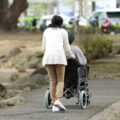Two Young Persons Living with Rural Migration: Through Interviews in Toyama-go district of Iida City, Nagano Prefecture
Yamaguchi Ryutaro, Associate Professor, Ohtsuki City College
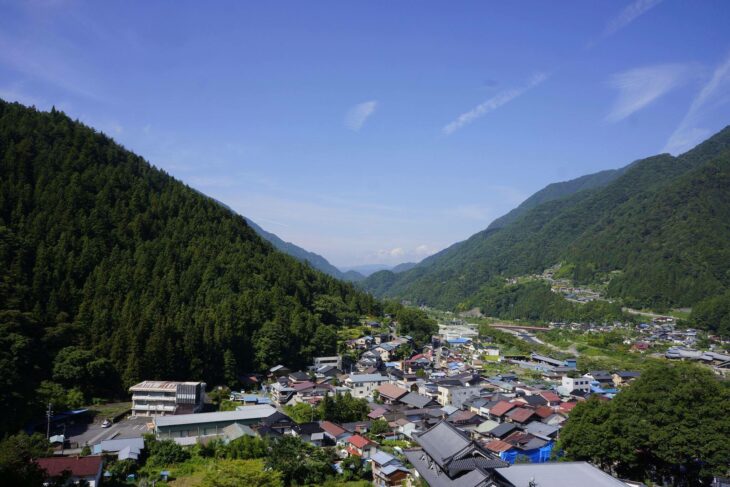
View of Toyama-go district from Ryuenji Temple
All photos: Yamaguchi Ryutaro
How do young people living in rural areas make a living? We think about how to best formulate policies to encourage young people to migrate to and settle in rural areas based on interviews with young people who know the reality of this way of life, including daily life, work, and connections with the local community.
Introduction
One of the goals of the reshuffled second Abe Cabinet, established in 2014, was to overcome population decline and vitalize local economies in the so-called regional revitalization project, seeking to rectify the unbalanced population concentration in the Tokyo metropolitan area as well as to revitalize and curb population decline in rural areas with a decreasing birthrate and aging population. This has been promoted through regional revitalization promotion grants, the transfer of government organizations to rural areas, the creation of special zones, and especially for young people, the promotion of migration and settling in the form of U-turns and I-turns.[1]
However, while the regional revitalization project adjusted tax revenue gaps among jurisdictions and ensured fiscal resources through subsidies with incentives and so forth, local governments lacked the capacity to formulate plans, as in the cases of local governments that rely on “outsourcing” due to manpower shortages, which led some to question the practical aspects of the regional revitalization project (Sakamoto 2018).
In addition to this problem on the macro level, we come across many challenges when considering the regional revitalization project with regard to the lifestyles of rural migrants and especially young individuals. Young people tend to face instability both economically and in their lifestyles. They also undergo many life stage changes, such as employment, marriage, and childbirth. When more young people move to and settle in rural areas, including changes in the COVID-19 pandemic environment, then the choice to settle may have the effect of narrowing down the young person’s life options. When considering how to design a policy to promote young people’s rural migration, it is necessary to keep a micro-level perspective of individual young persons’ lifestyles in mind.
When it comes to the lifestyles and rural migration of young people, sociology has focused primarily on their life difficulties, such as identity crisis, poverty, and exploitation. Kutsuwada Ryuzo’s discussion on the less mainstream topic of “rural youth” is noteworthy (Kutsuwada 2017). In addition to the positive aspects of a fulfilling rural life and the vibrancy of these young migrants’ lifestyles, he analyzes the complaints of young people living in rural areas and what is necessary to resolve those complaints based on data aggregation and in-depth interviews. He writes that the lives of young people are not necessarily limited to where they reside, and points out that future discussions about rural migration policy for young people should be based on individuals’ living and employment areas, without being hung up on administrative districts. In other words, he believes that the relationship between young people’s lives and the local area in the countryside is changing, moving away from the perceptions of those involved in the administration and rural issues.
In this article, I interview young people who have actually moved to rural areas, asking about their lifestyles and topics such as what kinds of lives they live as well as the employment and local community that form the basis of that. Using that, I would like us to think about the future of regional revitalization policies for young people.
Two people who created a hub that connects local community and the younger generation
The interviewees are Kimata Gento and Toyama Norihiro, who currently (as of January 2022) live in the old Minami-shinano district of Iida City, Nagano Prefecture[2] (hereinafter Toyama-go, as this district is named after Toyama River, a tributary of the Tenryu River).
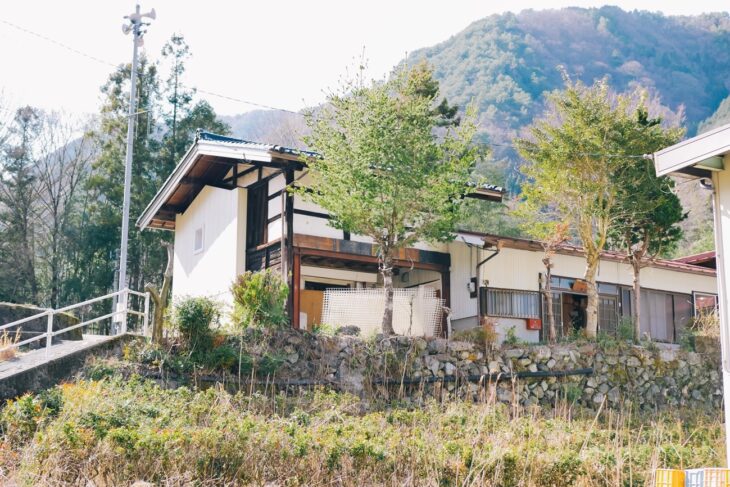
The share house renovated from an old house
Previously, I have conducted ongoing interviews and field surveys on the fiscal situations of local governments together with my collaborator Kurachi Shintaro (Meiji University) on the themes of local government finance and the sustainability of local autonomy.[3] In particular, there was a period during the COVID-19 pandemic when it was not possible to conduct research in Iida City (Nagano Pref.), which underwent a municipal merger in 2005, but we have conducted field surveys continuously since 2020.[4] Through this, I got to know Kimata and Toyama, who were based in Com(m)pass House[5], a share house that serves as a local community for the younger generation. Through this share house, they act as a hub in the region that connects various people inside and outside Iida City. In this article, I would like to consider rural migration and regional sustainability by describing their stories, their relationship with the local area, and their future activities through interview surveys. First, I want to give an overview of their stories.
Kimata was born in Gifu Prefecture and went on to study at a university in Tokyo after graduating from high school, and later had the opportunity to learn about hunting. As he was searching for an active hunter to learn about hunting in practice, he met a hunter living in the Toyama-go and visited Toyama-go several times to go out into the woods. This resulted in him moving to Toyama-go six years ago in an I-turn. After the move, he made a living mainly by working in a nursing care and welfare facility, but he recently left that job, and continues hunting as his lifework while making videos and running a restaurant as a self-employed person.
Toyama was born and raised in the old Minami-shinano village and commuted to a high school in central Iida City from his home. After graduation, he went to a university in Tokyo. Subsequently, he went job hunting and was offered a job by a company in Tokyo and a company in Iida City. He decided to make a U-turn and returned to Toyama-go six years ago, from where he has a one-hour commute to central Iida City. Throughout his high school and university days, he often brought good friends to his parents’ home where they hung out, and while he obviously enjoyed life in Tokyo, spending time with friends at his parents’ home was more important, which became a deciding factor for his U-turn.
This time, I interviewed them about (1) the reason why they started the share house, (2) the actual running of the share house, (3) how to make a life in a rural area, (4) how to manage a local community, and (5) the relationship between rural youth and migration.
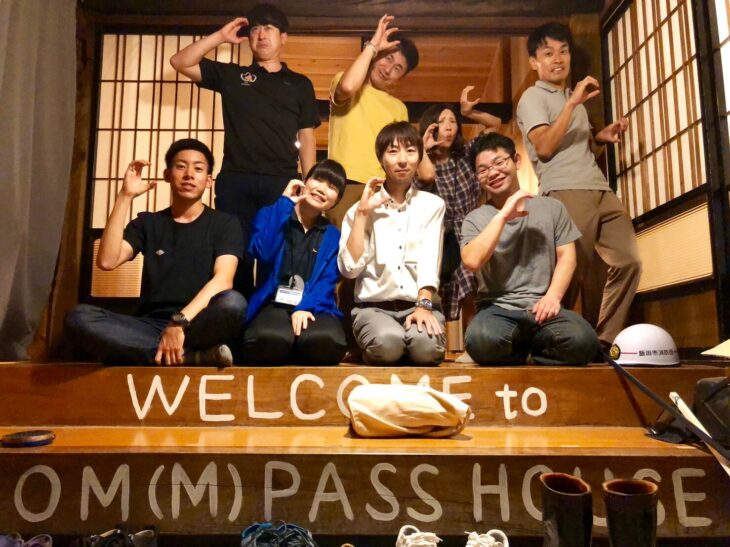
Com(m)pass House entrance, with a record of the share house in the form of commemorative photos with guests
How the share house was started
Kimata: First, I did my I-turn and Toyama did his U-turn in the same year, and we both joined the local fire department around the same time.
Toyama: Originally, a friend who was studying urban development in architecture and I wanted to do something together for the local area and created a private organization called the Mountain Life Company to disseminate information about the Toyama-go, organize events, and frequently bring in people.
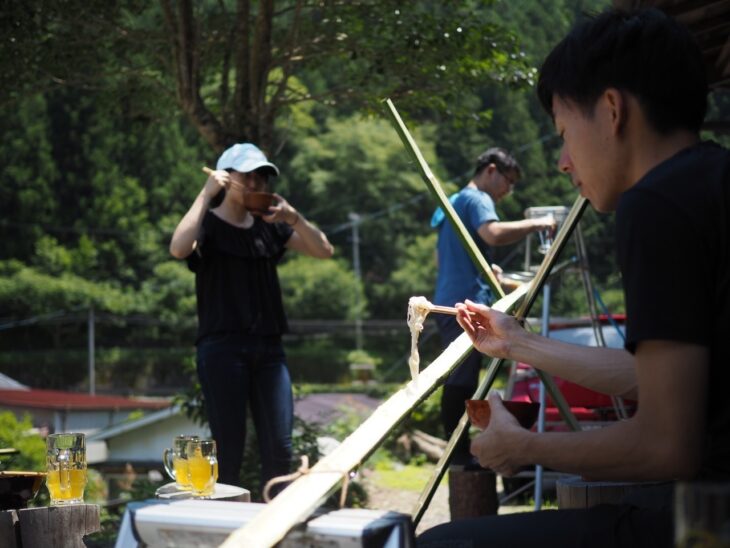
Event at Com(m)pass House (nagashi-somen)
It seems you knew about Toyama’s activities even before they met. You hit it off with Toyama, whom you met at the fire department, and the Mount Life Company also spread information about your hunting. How did those activities lead to a share house?
Kimata: I was looking for a place to live. When I first moved to Toyama-go, I lived in an apartment in municipal housing, but it was difficult to butcher animals and keep hunting dogs there, so I was thinking of finding a vacant house suitable for hunting. The number of events with Mountain Life Company was also increasing at the same time, so I wanted a place where people could gather more easily.
There were some younger people thinking about doing a U-turn at the same time, so it seems you also wanted to motivate them.
Kimata: We agreed that if there is a flow that allows us to do what we want to do and to achieve what we think is fun, that may become an opportunity to return to your hometown. So we started going in the direction of creating a hub. We also wanted to hang out and do events with a person coming to the neighboring Kamimura district as a Local Vitalization Cooperator[6] and create connections with young people in different areas.
It was then that you found a vacant house, so you decided to renovate it and turn it into a share house. However, it takes equipment and funds to make it into a hub not only for accommodation but also for people to gather. How did you handle that?
Kimata: A young guy at the Mountain Life Company had experience of renovating a vacant house with crowdfunding when he was a student. We decided to try that as well. With support from various people around us, we were ultimately able to collect more than one million yen through crowdfunding.
All the money you collected was used for the renovation costs, and you planned an event at the share house for the donors, sending invitations and doing other things as rewards. The crowdfunding itself functioned to expanding your connections with people.
A share house as a community of local youth
In parallel with managing the share house, both of you work on weekdays and are free on Saturdays and Sundays, but you say that there was always someone coming by Com(m)pass House every week. Some said, “I saw it on social media,” and you were able to connect with many people.
Kimata: A lot of connections were also made among the people who attended the events, and there were really unexpected things, like some actually marrying each other.
Toyama: Com(m)pass House has two axes, namely “a place where you achieve what you want” and “a place where people gather.” As a result, we had more people coming than anticipated, with many people coming several times even if they live in Tokyo or Nagoya. It feels like Kimata and I spent those two years talking about what it is that attracts people here. Yet we didn’t expect that it would just be the two of us still running the share house, when we had planned to become four.
About two years after you started the share house, Com(m)pass House had a major turning point. It was Toyama leaving Com(m)pass House when he got married and then it was COVID-19.
Kimata: When Toyama left, the COVID-19 pandemic started, and we had no choice but to change. When it was no longer possible to get people together and have events, I felt that it was time to calmly look at Com(m)pass House and what we want this hub to be.
As you were discussing what to do with Com(m)pass House in the future, you decided to scrap the share house format for the time being. This was not meant to be a negative for the local community, but although you were stepping back from being center of the hub, you were hoping for the next generation to take over. You wanted those people to decide what form it should take.
Kimata: I still live there, but I may move because of my current work, so nothing changes, we will close the place called Com(m)pass House for now. I guess building a hub for the future is something that lies ahead of us.
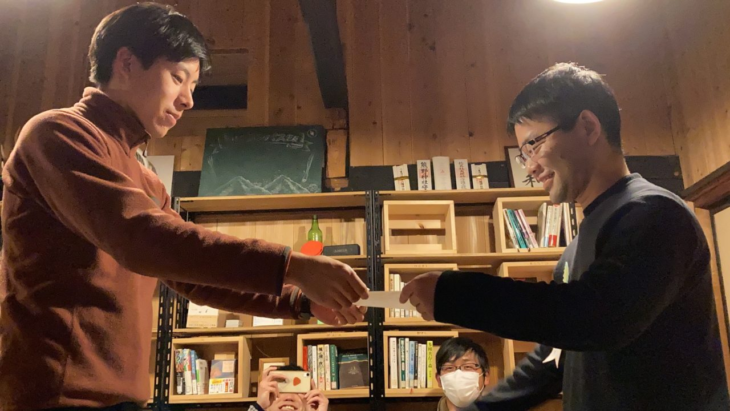
Toyama (right) leaving Com(m)pass House and Kimata (left) sending him off
How to make a life in a rural area
One challenge that many rural areas have is what to do with your occupation when actually living in Toyama-go and making a living for yourself.
Kimata: I think that a big part of work depends on things like your age and how you want to set up your life in the future, and that will lead to different values regarding work. When I came to Toyama-go, I was single and wanted to hunt, so I found work after coming here. In that sense, I think work was low priority for me.
The question is what to prioritize. In terms of work to earn a livelihood, this is an aspect that is actually growing in some areas as the working generation ratio is decreasing.
Toyama: I don’t think there’s no work in Toyama-go. In fact, I often hear about labor shortages. However, if you have certain criteria for work and life, it might be difficult to be able to work and live in a way that matches those criteria, so I think that there is a certain number of people who find this to be a hurdle. I think that the possibility of working remotely will increase in the future.
Toyama, you spend an hour commuting to central Iida City, but are there many other people in the area who work like this?
Toyama: I think there’s quite a few. I think that one hour of commuting is not so astounding from a national perspective. The question is whether you want to live in Toyama-go with that time in mind. I know classmates who live in urban Iida City and don’t return to their hometowns, so I guess it depends on the person.
Living in Toyama-go is more inconvenient than living in urban areas, so how do you feel about this?
Kimata: I think it probably is inconvenient, but you get used to it. “Home is where you make it” is a great saying, so it hasn’t been a problem at all.
Toyama: For example, if you want to buy something in the middle of the night, you do wish there was a convenience store, but you can get the bare necessities as well as order things online, and you can take the car if something comes up.
If you go to central Iida City, which is an hour’s drive away, you can get most things, so the inconvenience may not be such a problem if you have a car.
How to manage a local community
It’s difficult to get an intuitive feel for how a community like a fire department would connect people living in a city, so what kind of fire department is it in Toyama-go?
Toyama: The fire department also has an aspect of facilitating communication with people you wouldn’t meet if you just work and live normally. Of course, it is optional to join the fire department, but if you do join, you will be surprised at how much fun you have talking about various things with people your age as well as seniors. They say that this is handy if there’s a fire or something in the area… For instance, that’s the case with festivals. If you join the festival preservation society, you have another community there. There used to exist a young men’s association that was in charge of the summer festival. I think the difference lies in whether there is something that facilitates connections, which is not limited to the fire department.
The share house is one such community, but how were your relations with the local government and local residents as you were managing it?
Toyama: When we launched Com(m)pass House, we had pretty great cooperation with the people around us, and we received wood as well. When I started the Mountain Life Company in the first place, I consulted with the director of the community learning center, meaning an administrator officer, and I think things became relatively easy. They would encourage me and introduce me to influential people in the area. In that sense, I think we were blessed with good locals.
Kimata: We received quite a lot of help with Com(m)pass House from local residents and administrative officers. I think we were able to do things so freely because we didn’t run it as a business. I feel we actively did what we wanted and then received support from the people around us. From the outset, our goal was to do something we enjoy, so it might have looked a bit lax from the outside, but that was our stance.
On the relationship between rural youth and migration
Do you feel through your own experiences that efforts are being made to promote young people’s migration by national and local governments and others, in terms of increasing the number of young people who settle in rural areas?
Kimata: This is just my own feeling, but I think there are many patterns of hurdles to migration. Wanting to hunt like I did is not a major pattern, but for those who wish to move, there are ministerial policies and there are people who offer support in various ways. Moreover, there are also study programs for parents and children in Toyama-go,[7] so I feel that the scope for moving is becoming wider.
It seems that the migration support for young people and parents that local governments have implemented as part of the regional revitalization project in recent years is yielding visible results.
Kimata: I think what I feel as an observer is that there is an aspect of wanting to leave your local area or change where you live because of a certain circumstance, such as work or hobby, be it an I-turn or a U-turn, or whether it involves local people themselves.
The challenge in supporting young people’s migration and settlement is how to handle young people’s life stage as it is prone to change.
Looking back on the interviews
What the two interviewees have in common is that what first motivated them to move was relationships with friends and other connections with people. Com(m)pass House was an extension of their relationships with people, which is why it became a place where young people thinking about doing a U-turn, young people doing an I-turn, and various other people could get together. It seemed to me that their contributions to enhancing the lives of young people through community forming centering on the share house and with the support of those around them constituted a major achievement with regard to promoting migration and settlement.
As their life stages change, the share house will be closed for now (planned), but in general terms, it just shows that the lives of most people are fluid in the first place and not that the community itself will be lost. The experience and knowledge for community formation is intact. You could say that what is important is to pass on that experience and knowledge to the next generation.
Currently, in Toyama-go, people younger than Toyama himself are starting activities as the “Toyama-go expedition team.” Unlike the share house, this initiative conveys the charm of the area while generating jobs by themselves, by providing activities using the Toyama River such as rafting and river trekking. The two have interacted with them at the fire department and Com(m)pass House. In this way, the young people’s community in the local area will surely continue to exist even as it undergoes change.
In the interviews, they also pointed out that what young people prioritize in their lives is an issue when it comes to working in rural areas. Labor shortages have become chronic throughout Japan due to the decrease in the number of people of working age, and the government also enacted the Act on Promotion of Specific Community Development Projects to Deal with Rapid Decline in Local Population in 2020 to develop a system to support multi-workers with multiple jobs. Such systems need people who assign a high priority to rural migration. Of course, it is important to improve the environment for those who wish to move to rural areas, but if they can’t continuously feel that living in the countryside is meaningful, it will not be possible to sustain the motivation needed to keep living there. In other words, it is necessary for regions to become places that make people think “Home is where you make it” even if there are inconveniences associated with rural living. At the same time, this would be predicated on the assumption that changing life styles will be accepted.
For the two, the running of the share house must have been a major factor in supporting the value of living in Toyama-go. Regarding the management of the local community, the two took a stance of doing what they find enjoyable and received support for this from those around them. This structure can perhaps be seen as one model for the kind of youth support that the regional revitalization project is aiming for.
However, the way the regional revitalization project is implemented does not always match changes in young people’s lives. The measures for promoting young people’s rural migration and settlement in the regional revitalization project have numerical targets for the local governments from migration to settlement. The closing of Com(m)pass House could mean that a local community has become untenable or lost. However, if we consider how changes are prone to happen in the life stages of young people, this is something that may happen quite frequently. If young people don’t feel that both the entrance and exit are wide, they probably won’t feel the possibility of expanding their own life options either.
In other words, differences in how we perceive young people’s life stage changes become an important point in thinking about future youth policy. National and local government policy to support young people’s migration and settlement has only existed for a few years and is fairly new, but you could say that it has achieved certain results in terms of building communities with a wide entrance. What is needed in the future is ways to mature this policy.
It will be important to actively support the creation of environments that create connections between people according to the life stages of each and every young person, recognizing the diverse choices that they make. To do that, it will be necessary to think outside the framework of conventional administrative divisions and particular local units, and rather think in terms of the living and employment area of young people (Kutsuwada 2017). I expect that there will be a need for building open communities that can accept the later diverse choices made by young people who migrate there.
Acknowledgements Kimata Gento and Toyama Norihiro cooperated by taking part in several long interviews. I would like to take this opportunity to express my gratitude. I would also like to thank everyone in Toyama-go who created these interview opportunities. The statements in this article regarding the national and local government policy and the ways young people interact with the local community are entirely my own views, and I am solely responsible for them.
References
Kutsuwada Ryuzo (2017), The Joys of Rural Living and Young People, Keisoshobo; Sakamoto Makoto (2018), “The Current Situation and Challenges of National-Regional Relations as Highlighted by Regional Revitalization Policy: Based on the results of a questionnaire of municipalities on the formulation of ‘Regional Comprehensive Strategy,’” Jichisouken (Monthly Review of Local Government), vol. 474.
Translated from “‘Tokushu 1 Chiho no Kurashi wo Tsukuru, Sasaeru’ Chiho-iju wo meguru futarino wakamono no ikikata—Naganoken Iidashi Toyama-go intabyu (‘Special Feature 1 Creating, supporting local life’ Two Young Persons Living with Rural Migration: Through Interviews in Toyama-go district of Iida City, Nagano Prefecture),” THE TOSHI MONDAI (Municipal Problems), May 2022, pp. 37–46. (Courtesy of The Tokyo Institute for Municipal Research) [May 2022]
Keywords
- Yamaguchi Ryutaro
- Ohtsuki City College
- rural migration
- regional revitalization
- Toyama-go
- Iida City
- Nagano Prefecture
- U-turn
- I-turn
- migrants
- promotion of migration
- subsidies
- work
- employment
- lifestyles
- life changes
- rural youth
- hunting
- share house
- crowdfunding
- Compass House
- fire department




